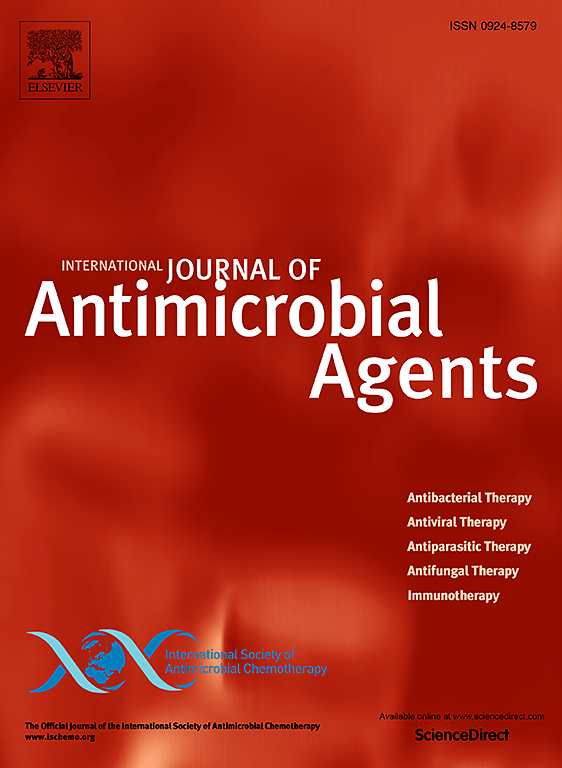Posaconazole effectiveness in rare invasive fungal infections: A systematic literature review
IF 4.6
2区 医学
Q1 INFECTIOUS DISEASES
International Journal of Antimicrobial Agents
Pub Date : 2025-02-27
DOI:10.1016/j.ijantimicag.2025.107482
引用次数: 0
Abstract
Introduction
Mucormycosis, hyalohyphomycosis, chromoblastomycosis, and fungal mycetoma are rare invasive fungal infections (IFIs) that cause significant morbidity and mortality in immunocompromised patients. Few effective treatment options are available for these IFIs.
Methods
We performed a systematic literature review of MEDLINE and Embase to identify studies published from 2005 (year of posaconazole approval) to 22 October 2022, reporting the efficacy/effectiveness of posaconazole monotherapy or combination therapy for treating mucormycosis, hyalohyphomycosis, chromoblastomycosis, and mycetoma. Positive outcomes or positive clinical outcomes were defined as reporting of a positive efficacy/effectiveness measure (i.e. no relapse, response, cure, radiological improvement, clinical/symptom improvement, or survived therapy).
Results
Of 3207 articles identified (after removing duplicates), 533 articles (mostly case reports) were included. Positive clinical outcomes with posaconazole therapy were observed in most patients with mucormycosis (74.8%, 1197/1601), hyalohyphomycosis (58.5%, 62/106), chromoblastomycosis (90.5%, 19/21), and mycetoma (100%, 5/5). Overall survival was around 70% or greater across the IFIs examined. Positive response was higher in second-line monotherapy than first-line monotherapy in mucormycosis and chromoblastomycosis. Higher mortality was observed with combination therapy than monotherapy in mucormycosis and hyalohyphomycosis infections (except for first-line use in mucormycosis). Positive clinical outcome was 78.6% and overall survival was 78.6% in 323 coronavirus disease-associated mucormycosis infection cases.
Conclusions
Despite the rarity of these IFIs, substantial data have been published since posaconazole was initially approved in 2005, and the real-world case reports demonstrate that posaconazole is an effective therapeutic option alone or in combination for the treatment of these rare IFIs.

泊沙康唑治疗罕见侵袭性真菌感染的有效性:系统文献综述。
简介:毛霉病、透明丝孢菌病、成色菌病和真菌足菌瘤是罕见的侵袭性真菌感染(IFIs),在免疫功能低下患者中引起显著的发病率和死亡率。这些国际金融机构几乎没有有效的治疗方案。方法:我们对MEDLINE和Embase进行了系统的文献回顾,以确定2005年(泊沙康唑批准之年)至2022年10月22日发表的研究,报告泊沙康唑单药或联合治疗毛霉病、透明丝孢菌病、成色菌病和足菌肿的疗效/有效性。阳性结果或阳性临床结果被定义为报告了积极的疗效/有效性指标(即,无复发、无反应、治愈、放射学改善、临床/症状改善或存活治疗)。结果:3207篇文献(剔除重复)中,533篇文献(多为病例报告)被纳入。泊沙康唑治疗在毛霉菌病(74.8%,1197/1601)、透明丝孢菌病(58.5%,62/106)、成色菌病(90.5%,19/21)和足菌肿(100%,5/5)患者中临床结果均为阳性。在被调查的国际金融机构中,总体存活率约为70%或更高。在毛霉病和嗜色菌病中,二线单药治疗的阳性反应高于一线单药治疗。在毛霉病和透明丝酵母菌感染中,联合治疗的死亡率高于单一治疗(毛霉病一线治疗除外)。323例冠状病毒病(COVID)相关毛霉菌病感染的阳性临床结局为78.6%,总生存率为78.6%。结论:尽管这些ifi罕见,但自2005年泊沙康唑最初被批准以来,已经发表了大量数据,并且实际病例报告表明泊沙康唑是单独或联合治疗这些罕见ifi的有效治疗选择。
本文章由计算机程序翻译,如有差异,请以英文原文为准。
求助全文
约1分钟内获得全文
求助全文
来源期刊
CiteScore
21.60
自引率
0.90%
发文量
176
审稿时长
36 days
期刊介绍:
The International Journal of Antimicrobial Agents is a peer-reviewed publication offering comprehensive and current reference information on the physical, pharmacological, in vitro, and clinical properties of individual antimicrobial agents, covering antiviral, antiparasitic, antibacterial, and antifungal agents. The journal not only communicates new trends and developments through authoritative review articles but also addresses the critical issue of antimicrobial resistance, both in hospital and community settings. Published content includes solicited reviews by leading experts and high-quality original research papers in the specified fields.

 求助内容:
求助内容: 应助结果提醒方式:
应助结果提醒方式:


